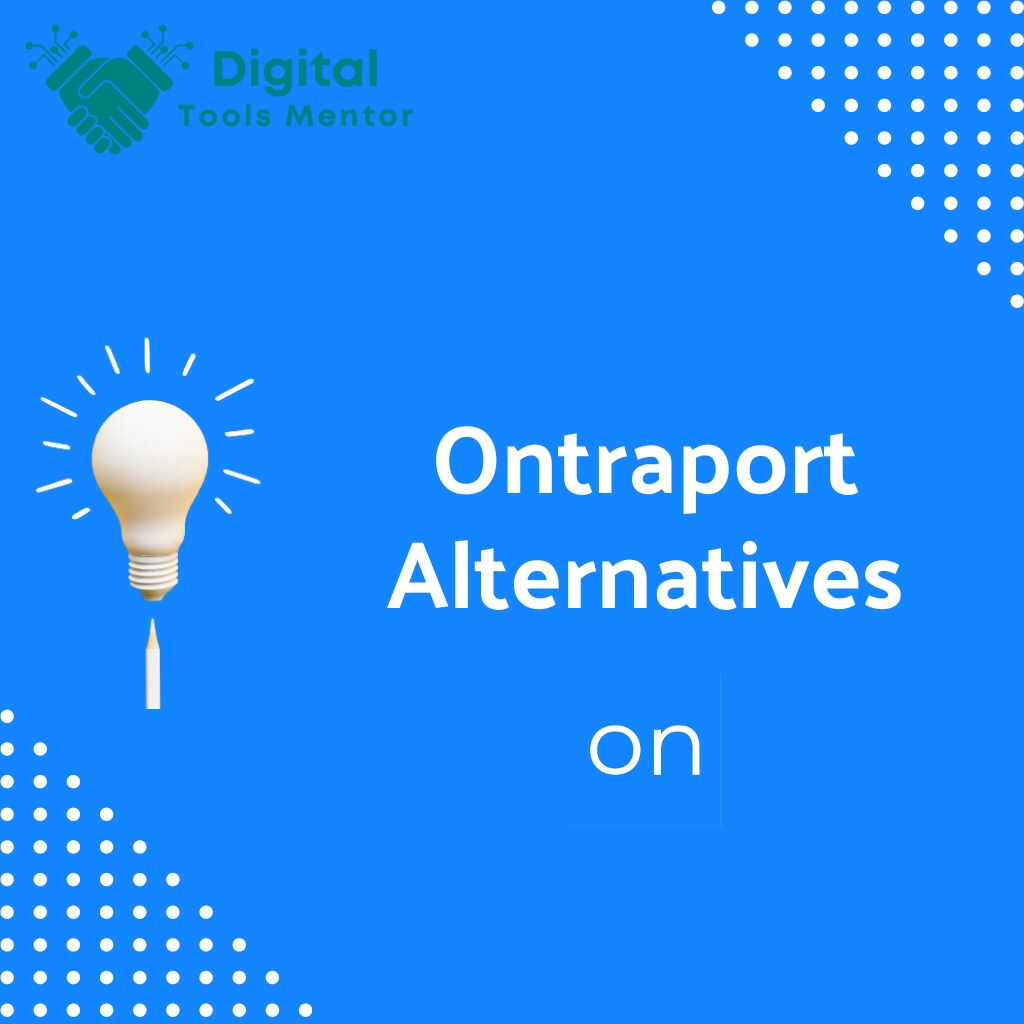Top 8 Ontraport Alternatives for Streamlined Marketing Automation
In today’s fast-paced digital world, marketing automation tools are indispensable for businesses aiming to enhance customer engagement, improve lead conversion rates, and boost overall sales performance. These tools streamline complex marketing tasks, automate repetitive processes, and ensure that businesses communicate with their customers at optimal times with relevant messages. By effectively utilizing marketing automation, companies can maintain a consistent presence across various channels, thereby increasing efficiency and allowing marketers to focus on more strategic tasks. Ontraport is a well-known player in the realm of marketing automation, providing a robust suite of tools that include email marketing, CRM capabilities, landing pages, and more. Designed to support small to medium-sized businesses, it helps users manage their online marketing, sales, and content all in one platform. Despite its comprehensive features, some businesses may find themselves seeking alternatives due to factors such as Ontraport’s pricing structure, which can be steep for startups and small businesses, or its user interface, which might come across as complex for those new to marketing automation. Additionally, specific business needs, such as more advanced analytics, different integration capabilities, or more tailored customer support, might not be fully met by Ontraport. As businesses evolve, so too do their needs, prompting many to explore Ontraport alternatives that could offer a better fit for their unique marketing strategies and goals. This guide will delve into the top 8 alternatives to Ontraport, providing you with the insights needed to make an informed decision on which platform could best support your business’s growth and success.
7 Reasons to Consider Ontraport Alternatives
Choosing the right marketing automation platform is crucial for maximizing the effectiveness of your marketing efforts and ensuring the best possible return on investment. While Ontraport offers a robust suite of features, there are several reasons why businesses might consider exploring alternatives:
- Cost Efficiency: One of the most common factors influencing the switch from Ontraport to another platform is cost. For startups and small businesses, the pricing of Ontraport may be a significant hurdle, especially when budget constraints are tight. Alternatives might offer more flexible pricing plans that align better with the needs and capacities of smaller businesses or provide more value at a similar price point.
- Feature Set Requirements: Different businesses have unique needs based on their marketing strategies, industry demands, and customer engagement models. Ontraport provides a wide array of features, but some businesses may need specific functionalities that are either not as developed in Ontraport or are better executed by other platforms. This includes advanced analytics, deeper AI integration, or more specialized automation capabilities.
- Ease of Use: The complexity of a platform can be a decisive factor. If the learning curve for Ontraport is too steep for a company’s team, it might hinder rather than help their marketing efforts. Alternatives may offer a more user-friendly interface or better usability that can make it easier for teams to adopt and efficiently use the platform.
- Scalability: As businesses grow, their needs change, and they might find that Ontraport does not scale as smoothly or as cost-effectively as needed. Other platforms might offer better scalability options, allowing businesses to expand their marketing activities more efficiently without a significant increase in cost or complexity.
- Customer Support and Community: The level and quality of customer support can significantly affect user satisfaction. Businesses might seek alternatives that offer more responsive, comprehensive customer support or a more vibrant, resourceful user community.
- Integration Capabilities: Effective marketing automation tools should seamlessly integrate with other systems such as CRM software, social media platforms, and e-commerce solutions. If Ontraport’s integration capabilities are limited or cumbersome, businesses might look for other tools that can integrate more smoothly with their existing technology stack.
- Specific Industry Features: Certain industries might require specialized marketing tools tailored to their specific needs, such as compliance with industry regulations, handling of sensitive data, or specialized communication tools. If Ontraport doesn’t adequately address these specialized needs, an alternative platform that does could be a better choice.
By understanding these reasons, businesses can make a more informed decision when considering whether to stick with Ontraport or switch to an alternative that might better meet their specific needs and contribute more effectively to their overall business strategy.
Top 9 Criteria for Choosing the Best Ontraport Alternative
Selecting the right alternative to Ontraport requires a careful evaluation of several key criteria to ensure the new platform meets your business needs efficiently and effectively. Here are the essential factors to consider when assessing potential alternatives:
- Feature Richness: Evaluate whether the alternative provides all the necessary tools to fulfill your marketing strategies. Key features might include email marketing, lead management, campaign automation, and customer relationship management. The richness of these features, such as advanced personalization, segmentation capabilities, and multi-channel marketing options, should also be considered to ensure comprehensive marketing efforts.
- Ease of Use: The platform should have an intuitive user interface that makes it easy for your marketing team to execute campaigns without extensive training. A platform that is easy to use can significantly reduce onboarding time and increase productivity by allowing teams to focus more on strategy and less on navigating the software.
- Integration Capabilities: The ability of the platform to integrate seamlessly with other tools used by your business is crucial. This includes CRMs, e-commerce platforms, social media channels, and analytics tools. Effective integrations eliminate data silos, enhance workflow automation, and ensure a unified approach to customer information and marketing strategies.
- Customer Support Quality: High-quality customer support is vital, particularly when transitioning to a new platform or troubleshooting complex issues. Evaluate the responsiveness, availability, and helpfulness of the customer support team. Also, consider whether the platform offers a variety of support channels such as live chat, phone support, and online resources.
- Pricing Flexibility: Look for pricing plans that match your business’s size and budget. The best alternatives offer transparent pricing without hidden costs and provide scalability to accommodate growth. Plans should be flexible, allowing you to choose features you need without paying for unnecessary extras.
- Scalability: The platform must be able to grow with your business. This means it should handle increased loads, more complex marketing campaigns, and a growing number of contacts without performance degradation.
- Security and Compliance: Ensure that the platform adheres to industry-standard security practices and complies with relevant regulations such as GDPR, HIPAA, etc., particularly if you handle sensitive customer data.
- Performance and Reliability: The platform should be reliable with minimal downtime, ensuring that your marketing activities are not interrupted. Performance metrics like load times, email deliverability rates, and the efficiency of data processing are also crucial.
- User Feedback and Reviews: Look at reviews and testimonials from other users, especially those in a similar industry or with similar business sizes. User experiences can provide valuable insights into the platform’s practicality and effectiveness in real-world scenarios.
When evaluating Ontraport alternatives, it’s important to align these criteria with your business’s size and specific marketing needs. A platform that suits a small startup might not be ideal for a large enterprise with complex marketing demands. By carefully considering each of these criteria, you can choose a marketing automation platform that not only meets your current needs but also supports future growth and success.
Top 8 Ontraport Alternatives for Streamlined Marketing Automation
1. ActiveCampaign
ActiveCampaign combines email marketing, marketing automation, and customer relationship management (CRM) functionalities into a robust platform designed to help businesses connect and engage with their customers. It excels in creating dynamic customer experiences through automated and personalized marketing efforts, making it a popular choice among businesses looking to scale their engagement strategies effectively.
Key Features:
- Advanced Automation: ActiveCampaign’s automation workflows are highly customizable and can handle complex sequences based on user behavior, preferences, and previous interactions.
- Segmentation and Personalization: Provides sophisticated segmentation capabilities, allowing users to deliver highly targeted content that increases engagement and conversions.
- Integrated Sales and CRM: Offers a seamless integration between marketing and sales processes with its built-in CRM system, enhancing lead nurturing and closing.
- Email Campaign Performance Tracking: Extensive reporting tools provide detailed insights into email campaign effectiveness, subscriber behavior, and more.
Pricing: ActiveCampaign offers tiered pricing, making it suitable for different business sizes and needs:
- Lite: Starting at $9 per month, providing basic marketing automation and email marketing features.
- Plus: Starting at $49 per month, includes CRM, landing pages, and lead scoring.
- Professional: Starting at $149 per month, adds machine learning capabilities, predictive sending, and attribution.
- Enterprise: Custom pricing, offering advanced features like custom reporting, custom mailserver domain, and dedicated account representative.
Pros and Cons:
- Pros:
- Extensive automation and CRM integration streamline customer interactions and save time.
- Powerful segmentation and personalization tools enhance the relevance of campaigns.
- Scalable solutions cater to a range of business sizes and needs.
- Cons:
- The platform can be complex, particularly when setting up detailed automation workflows, which might require a steeper learning curve.
- Higher tier plans, necessary for unlocking more sophisticated features, can be expensive for smaller businesses.
Best For: ActiveCampaign is ideally suited for small to medium-sized businesses and enterprises that require deep automation capabilities coupled with a strong CRM solution. It is particularly beneficial for those in the e-commerce, digital marketing, and B2B industries, where nurturing leads and converting them into sales are critical. The platform’s advanced features support businesses aiming to implement comprehensive, data-driven marketing strategies that drive customer engagement and revenue growth.
2. HubSpot
HubSpot is a comprehensive, cloud-based growth platform that unifies software for marketing, sales, and customer service. Known for pioneering the inbound marketing methodology, HubSpot helps businesses attract, engage, and delight customers by delivering content that is relevant and helpful, rather than disruptive. Its suite of tools is designed to support every stage of the customer lifecycle, making it a holistic solution for managing customer relationships and driving growth.
Key Features:
- All-in-One CRM: Centralizes customer data across marketing, sales, and service, providing a seamless user experience and single source of truth.
- Inbound Marketing Tools: Offers tools for SEO, blogging, social media, and content creation to attract the right audience and convert leads.
- Advanced Automation: HubSpot includes powerful automation capabilities across emails, workflows, and CRM processes that save time and personalize customer interactions.
- Analytics and Reporting: Extensive reporting options for detailed insights into every aspect of the business operations and marketing performance.
- Integration Ecosystem: Features a vast marketplace of integrations, connecting HubSpot with other software tools and extending its functionality.
Pricing: HubSpot offers various pricing tiers, which can be used individually or bundled:
- Free Tools: Basic functionalities of CRM, marketing, sales, and customer service platforms.
- Starter: Starting at $50 per month, adds simple automation and customization features.
- Professional: Starting at $890 per month, for automation and optimization of marketing, sales, and customer service workflows.
- Enterprise: Starting at $3,200 per month, includes advanced features for larger organizations that need scalable solutions and additional security.
Pros and Cons:
- Pros:
- Integrated approach across sales, marketing, and service, enhancing consistency and efficiency.
- Strong focus on inbound marketing helps in attracting high-quality leads.
- Extensive customization and integration capabilities adapt to diverse business needs.
- Cons:
- Can become quite expensive as you add functionalities and scale up.
- Complexity of the full suite might be overwhelming for smaller teams or those new to CRM and marketing platforms.
Best For: HubSpot is best suited for medium to large businesses that benefit from its all-encompassing suite of tools across marketing, sales, and customer service. It’s particularly effective for companies that adhere to an inbound marketing strategy and those in industries like tech, professional services, and healthcare, where long-term customer relationships are key to business success.
3. Brevo (SendinBlue)
Brevo, previously known as SendinBlue, is a digital marketing platform that combines email marketing, SMS campaigns, and automation into one interface, making it a versatile option for businesses looking to manage multiple aspects of their digital communication in one place. Renowned for its user-friendly design and cost-effective solutions, Brevo is ideal for small to medium-sized businesses aiming to enhance their marketing efforts without breaking the bank.
Key Features:
- Email and SMS Marketing: Allows users to manage email and SMS campaigns from a single platform, streamlining campaign management and execution.
- Marketing Automation: Features an intuitive automation builder that lets businesses create workflows for engaging with customers based on their behavior and data.
- Transactional Email and SMS: Supports sending transactional messages, which are crucial for e-commerce sites, such as order confirmations and shipping notifications.
- CRM Functionality: Integrates a lightweight CRM system that helps manage customer relationships directly within the platform.
- Segmentation and Personalization: Advanced segmentation tools allow for personalized marketing communications tailored to specific audience segments based on their interactions and behaviors.
Pricing: Brevo offers several pricing tiers based on the features and volume of emails/SMS:
- Free Plan: Includes a limited number of emails per day and basic features.
- Lite: Starting at $25 per month, includes no daily sending limit and some advanced features.
- Premium: Starting at $65 per month, adds features like marketing automation, Facebook ads integration, and multi-user access.
- Enterprise: Custom pricing for advanced needs, offering more sophisticated customization and dedicated support.
Pros and Cons:
- Pros:
- Integration of email and SMS marketing in one platform offers comprehensive communication tools.
- Affordable pricing makes it accessible for small businesses and startups.
- User-friendly interface helps new users get up to speed quickly.
- Cons:
- While it offers basic CRM functionality, it may not be robust enough for larger businesses or those with complex sales processes.
- Limited third-party integrations compared to larger platforms like HubSpot.
- Advanced features such as detailed reporting and analytics are only available at higher pricing tiers.
Best For: Brevo is best suited for small to medium-sized businesses, especially those in e-commerce, retail, and professional services that need effective, multi-channel communication tools at a reasonable cost. Its ability to handle both email and SMS marketing makes it particularly useful for businesses that rely on direct, timely communication with customers.
4. GetResponse
GetResponse is a comprehensive marketing platform that offers a wide array of tools designed to help businesses grow their audience, engage with customers, and optimize their marketing campaigns. Known for its ease of use and versatility, GetResponse integrates email marketing, automation, webinars, and landing pages into one streamlined service, making it a solid choice for businesses looking to expand their online marketing capabilities.
Key Features:
- Email Marketing: Provides advanced tools for creating engaging emails, including a drag-and-drop editor, autoresponders, and dynamic content.
- Automation Builder: Features a robust automation builder that allows users to create complex, customized workflows based on user behavior, making it easy to nurture leads and convert them into customers.
- Conversion Funnels: Unique to GetResponse, these pre-built automated sales funnels integrate email sequences with landing pages and ecommerce tools to drive sales.
- Webinar Hosting: One of the few email marketing platforms that include the ability to host live webinars, which can be integrated into overall marketing strategies.
- Landing Pages: Offers a variety of high-converting templates and testing tools to create effective landing pages that enhance lead capture and conversion.
Pricing: GetResponse’s pricing is tiered based on the list size and features required:
- Basic: Starting at $15 per month for email marketing, autoresponders, unlimited landing pages, and one sales funnel.
- Plus: Starting at $49 per month, includes automation builder, webinars (up to 100 attendees), and contact scoring.
- Professional: Starting at $99 per month, adds unlimited automation builders, webinars (up to 300 attendees), and paid webinars.
- Max: Custom pricing, provides advanced features like transactional emails, dedicated support, and single sign-on (SSO).
Pros and Cons:
- Pros:
- Integrated webinar functionality enhances engagement opportunities beyond traditional email campaigns.
- Comprehensive automation and conversion funnel tools streamline the lead generation and conversion processes.
- User-friendly interface with extensive template options makes it accessible for marketers of all skill levels.
- Cons:
- The cost can escalate quickly as additional features and larger subscriber lists are needed.
- While it offers many advanced features, some users might find the setup of these features slightly complex.
- Limited CRM features compared to dedicated CRM platforms like HubSpot.
Best For: GetResponse is ideal for small to medium-sized businesses and entrepreneurs who need a multifaceted platform that not only supports traditional email campaigns but also integrates advanced features like webinars and automated sales funnels. It is particularly beneficial for businesses in industries like education, digital marketing, and e-commerce, where direct engagement and detailed campaign tracking are crucial.
5. MailerLite
MailerLite is an intuitive and straightforward email marketing solution designed for businesses of all sizes, particularly catering to small businesses and startups. Its focus on simplicity and affordability does not compromise its robust set of features, which includes email campaigns, automation, landing pages, and a recently added website builder.
Key Features:
- Ease of Use: Known for its clean, user-friendly interface that makes it easy for beginners to create and manage email campaigns.
- Email Automation: Offers basic automation features for sending triggered emails based on actions like sign-ups, purchases, or other customer behaviors.
- Landing Pages and Pop-Ups: Includes tools to create custom landing pages and pop-ups that integrate seamlessly with email campaigns for consistent messaging and branding.
- Advanced Segmentation: Allows users to target emails based on subscriber behavior, preferences, and past interactions, which enhances the personalization and effectiveness of campaigns.
- Built-In Photo Editing and File Manager: Provides a streamlined workflow for managing images and content directly within the platform, which is especially useful for teams without dedicated graphic support.
Pricing: MailerLite’s pricing structure is appealing due to its simplicity and affordability:
- Free Plan: Includes up to 1,000 subscribers and 12,000 emails per month, with limited features.
- Premium Plans: Start at $10 per month for up to 1,000 subscribers with unlimited emails and more advanced features. The price increases based on the number of subscribers, adding more sophisticated automation and segmentation capabilities at higher tiers.
Pros and Cons:
- Pros:
- Cost-effective, making it ideal for small businesses and startups with limited marketing budgets.
- Simple and intuitive interface allows users to quickly get up to speed.
- Offers essential features like automation and segmentation that can significantly improve email marketing effectiveness.
- Cons:
- May lack some of the more advanced features found in more comprehensive platforms like ActiveCampaign or HubSpot.
- Automation capabilities, while useful, are not as advanced as those provided by some competitors.
- Limited customization options for email templates compared to more elaborate platforms.
Best For: MailerLite is best suited for small businesses, startups, freelancers, and content creators who value simplicity and affordability but still want effective tools for engaging with their audiences. It’s particularly useful for those who are new to email marketing or those with straightforward marketing needs that do not require highly complex automation or in-depth integrations.
6. Moosend
Moosend is an email marketing platform that offers a range of powerful tools designed to help businesses automate their marketing efforts efficiently. Known for its robust automation features and user-friendly interface, Moosend makes it easy for companies of all sizes to craft effective campaigns that engage and convert their audiences.
Key Features:
- Advanced Automation: Moosend’s automation workflows allow users to create detailed, behavior-triggered emails that personalize the customer experience and increase engagement.
- Real-Time Analytics: Provides instant insights into campaign performance, enabling marketers to make data-driven decisions and optimize their strategies on the fly.
- Customizable Templates: Features a variety of responsive email templates that can be easily customized to fit any brand’s style and needs.
- List Segmentation: Offers powerful segmentation tools that enhance campaign targeting by allowing marketers to divide audiences based on behavior, demographics, and engagement.
- Landing Pages and Subscription Forms: Includes intuitive tools to build effective landing pages and subscription forms, which help in capturing leads and expanding the subscriber base.
Pricing: Moosend’s pricing is structured to accommodate businesses of various sizes, emphasizing scalability and flexibility:
- Free Plan: Supports up to 1,000 subscribers and provides access to basic features, perfect for small businesses or those just starting out.
- Pro Plan: Starts at $8 per month and scales with the number of subscribers, offering unlimited emails, landing pages, transactional emails, and priority support.
- Enterprise Plan: Custom pricing that provides advanced features like dedicated account management, SSO, custom reporting, and more, tailored to larger businesses with specific needs.
Pros and Cons:
- Pros:
- Excellent automation and segmentation capabilities improve campaign relevance and effectiveness.
- Competitive pricing makes it accessible for startups and small businesses.
- User-friendly interface ensures ease of use, reducing the learning curve for new users.
- Cons:
- Although the toolset is robust, it might not offer the same depth of features as larger platforms like HubSpot.
- Integration options are somewhat limited compared to competitors.
- Advanced features and priority support are only available at higher pricing tiers, which could be a barrier for smaller companies.
Best For: Moosend is ideal for small to medium-sized businesses and e-commerce platforms that require advanced automation to personalize customer interactions without the complexity or cost of larger marketing platforms. It’s particularly well-suited for marketers looking for an easy-to-use solution that still offers powerful tools for growing and engaging their subscriber base.
7. ClickFunnels
ClickFunnels is not just an email marketing tool but a comprehensive sales funnel builder designed to help businesses automate their entire sales process and maximize revenue from each lead. This platform simplifies the process of creating, managing, and optimizing sales funnels, making it ideal for entrepreneurs and businesses focused on direct online sales.
Key Features:
- Sales Funnel Creation: Provides a range of customizable templates for various stages of the sales process, from lead capture to purchase completion.
- Integrated Marketing Tools: Combines email autoresponders, affiliate management, and webinar hosting within the sales funnels to create a seamless buying experience.
- A/B Testing: Allows users to test different versions of their funnels to find the most effective elements that drive conversions.
- Drag-and-Drop Editor: Makes it easy to build and customize landing pages without needing technical skills.
- Backpack Affiliate Program: Integrates an affiliate management system that enables users to create and manage their own affiliate programs to increase traffic and sales.
Pricing: ClickFunnels offers a straightforward pricing model with two main tiers:
- Standard Plan: Starting at $97 per month, includes all the basic tools for creating and managing sales funnels.
- Platinum Plan: Starting at $297 per month, offers additional features like unlimited funnels, pages, and follow-up funnels, plus priority support and advanced training materials.
Pros and Cons:
- Pros:
- Comprehensive toolset supports not just email marketing but the entire sales funnel.
- Intuitive design tools and user-friendly interface simplify the creation of complex funnels.
- Robust integration options with other platforms enhance functionality.
- Cons:
- Pricing is on the higher side, which may be a barrier for smaller businesses or solopreneurs.
- Focused primarily on sales funnels, which might not be necessary for businesses not centered around direct sales.
- Lacks some of the deeper marketing automation features provided by more traditional email marketing platforms.
Best For: ClickFunnels is best suited for entrepreneurs, small to medium-sized businesses, and marketers who are heavily focused on creating optimized sales funnels to increase direct sales. It is particularly valuable for businesses selling products or services online, such as digital courses, e-books, coaching services, and physical products that require an integrated approach to managing customer journeys from lead capture to sale.
8. SendPulse
SendPulse is a multi-channel marketing platform that offers a comprehensive suite of tools designed to facilitate communication with customers across various channels including email, SMS, and web push notifications. It is known for its ability to combine different messaging services into a single campaign, making it a versatile option for businesses looking to reach their audience wherever they are.
Key Features:
- Multi-Channel Messaging: Integrates email, SMS, and web push notifications in one platform, allowing for synchronized cross-channel campaigns.
- Automation 360: A feature that enables the creation of complex, automated workflows across all messaging channels based on user behavior and data.
- AI Features: Uses artificial intelligence to optimize the timing and content of messages, enhancing open rates and engagement.
- Subscriber Rating: Automatically rates subscribers based on their interaction level, helping to refine target audiences and personalize communications.
- Easy-to-Use Editor: Provides a user-friendly drag-and-drop editor for creating emails and other messages without needing advanced design skills.
Pricing: SendPulse adopts a flexible pricing model that caters to various business sizes and needs:
- Free Plan: Includes basic features with a limit on the number of subscribers and emails per month.
- Standard Plan: Starts at a base price which varies depending on the number of subscribers, adding more advanced features.
- Pro Plan: Includes full access to Automation 360, web push, and more detailed reporting.
- Enterprise Plan: Offers customized solutions for large businesses requiring more sophisticated service options.
Pros and Cons:
- Pros:
- Multi-channel approach maximizes reach and engagement by communicating with customers through their preferred channels.
- AI enhancements and automation tools streamline campaign management and effectiveness.
- Affordable pricing structure with a robust free plan suitable for small businesses.
- Cons:
- While versatile, it may lack some of the depth in specific channels compared to dedicated platforms.
- The interface and some tools might feel a bit clunky or outdated compared to more modern solutions.
- Advanced features and larger subscriber capacities can become relatively expensive.
Best For: SendPulse is well-suited for small to medium-sized businesses that require a flexible, all-in-one messaging solution to reach their audience across multiple channels. It’s especially beneficial for marketers looking to leverage automated campaigns that incorporate email, SMS, and push notifications in a unified strategy. Businesses in retail, e-commerce, and service industries will find SendPulse’s features particularly useful for engaging with customers at various touchpoints in their journey.
Read 23 Best Email Marketing Platforms in 2025
Conclusion: Top 8 Ontraport Alternatives for Streamlined Marketing Automation
Exploring alternatives to Ontraport presents a unique opportunity to align your marketing tools more closely with your business goals. Each of the platforms discussed offers distinct advantages, whether it’s enhanced automation capabilities, integrated CRM features, cost-effectiveness, or multi-channel communication strategies. By considering these alternatives, you can find a solution that not only meets your current marketing needs but also scales with your business as it grows and evolves.
The potential benefits of switching include gaining access to more intuitive interfaces, better pricing models, enhanced support, and features that Ontraport may not offer. The right platform can significantly increase your marketing efficiency, improve customer engagement, and drive higher conversion rates, ultimately impacting your bottom line positively.
As you consider these options, it’s essential to carefully assess your specific needs. Think about the size of your business, your industry requirements, the complexity of your marketing campaigns, and your budget. Understanding these factors will help you choose a platform that is the best fit for your business.
Take Control of Your Marketing Success
Discover the Perfect Marketing Platform for Your Business!
Are you ready to enhance your marketing strategy? Each of these Ontraport alternatives offers unique features that can transform your approach to customer engagement and sales. Don’t miss out on the opportunity to see what these platforms can do for you. Sign up for free trials or request demos today to test them firsthand. Experience the benefits and make an informed decision about which tool will best meet your business needs.
Start Your Free Trial Now !




